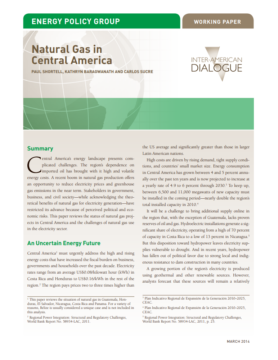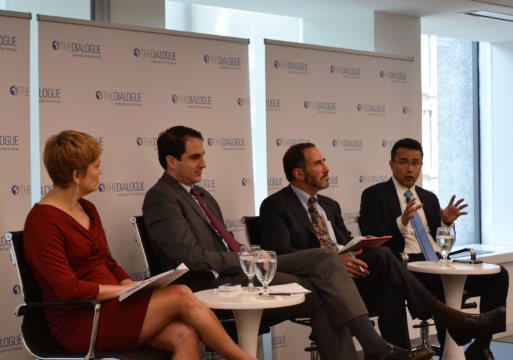
Natural Gas in Central America
Natural gas has the potential to reduce Central America’s high energy costs and mitigate its dependence on imported oil.
Despite setbacks, Central Americans are committed to a new energy future said regional energy leaders at the Inter-American Dialogue. With the support of the Institute of the Americas and the US Department of State, Teofilo de la Torre, the president of Costa Rica’s national electricity company, Minor López, Guatemala’s vice minister of energy, Carlos Trujillo of the Inter-American Development Bank, and Jeremy Martin of the Institute of the Americas, gathered to discuss the challenges facing Central American electric integration.
The speakers stressed the enormous benefits for all Central American countries if they were to connect power lines and trade electricity freely on a “seventh market,” beyond the six existing national energy markets. Through the Central American Electric Integration System, known by its Spanish acronym SIEPAC, the region is poised to do just that, with a new electric line running from Guatemala to Panama that is more than 90 percent complete.
SIEPAC would allow Central America to pool its energy resources and distribute them more efficiently across the region. Carlos Trujillos estimated that the shared electricity line would have the capacity to transmit up to 300,000 megawatts across borders to address a regional demand that is projected to double by 2020. This would make the provision of electricity more reliable, increasing energy security, and lowering electricity costs. However, several of the speakers cautioned that national regulators could impede the direct translation of these improvements into concrete benefits for the end consumer and called for more transparent electricity regulation at the national level.
Although Minor López is “confident that we will very successfully conclude this project,” other participants expressed doubt about the next steps for SIEPAC. All of the speakers acknowledged that the integration process has been slow, difficult, and at times frustrating. Participants voiced concern about whether Central Americans could overcome mistrust to fully integrate. López did admit that each individual country is hesitant to open its national market to a shared electricity market, and the mix of different electricity market structures causes difficultly. Participants were also concerned that SIEPAC is not taking advantage of an opportunity to expand the share of renewables in Central America’s electricity supply mix as much as it could.
Still, all of the speakers emphasized that SIEPAC is a carefully engineered project that has the confidence of all the countries. Jeremy Martin suggested that perhaps a public relations campaign educating Central Americans about SIEPAC’s benefits could mobilize popular support and create enough political will to take the final steps toward integration. Speakers also mentioned the need to strengthen regional regulators to give all sectors of the participating countries more confidence.
Despite the differences, one point remains clear: only full regional electric integration will maximize the benefits of SIEPAC. As the physical infrastructure for a regional electricity grid nears completion, the biggest challenge for SIEPAC is to successfully bring all parties to participate in the independent, regional electricity market. Although Teofilo de la Torre sees SIEPAC as only the beginning of a wider trend toward regional integration, it still faces many tests before it can prove that such cooperation is really possible in Central America.
Natural gas has the potential to reduce Central America’s high energy costs and mitigate its dependence on imported oil.
Comparatively high rates of energy use in China and Brazil have led to investment in many forms of energy, including renewables.
Latin America faces many challenges in developing its energy resources and providing clean, affordable and reliable energy. With presidential elections in Brazil, Mexico and Colombia next year, there is considerable uncertainty about future energy policy, as potential candidates in these countries have presented widely varying energy and economic policy platforms.

